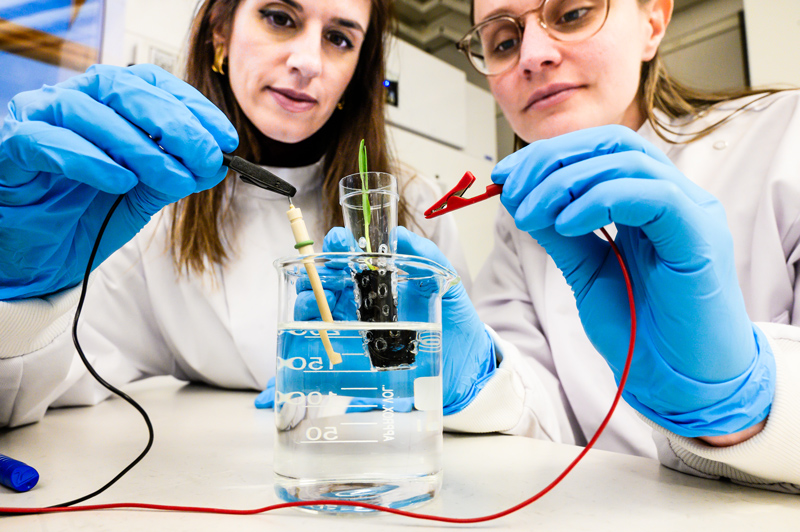This article also may be read in Arabic.
Working in a small lab in Germany in the early 1870s, botanist Julius von Sachs made a remarkable observation: A low-voltage current passed through the growth medium of germinating seedlings could make their roots grow toward a negative electrode. More than 150 years later, scientists are still fiddling with the mysterious ways electricity influences plant growth.
In a recent study published in the Proceedings of the National Academy of Sciences of the United States of America, researchers created eSoil, a cellulose-based scaffold infused with electrodes that, when powered up, boosted the growth of seedlings by up to 50%. The finding could pave the way for a fertilizer-free approach to agriculture.
Past studies have examined the use of electric fields in water and other solutions. “But what if we have this conducting substrate that the plant grows in—an electrode that can directly stimulate tissue?” asked Eleni Stavrinidou, a coauthor of the new study and a material scientist at Linköping University in Sweden.
Shocking Soil
Stavrinidou and her colleagues randomly selected some barley seedlings, put them in their eSoil scaffold, and let them germinate. Once the seedlings were 5 days old, the scientists divided them into two groups and applied low-power electricity to the electrodes for the next 5 days for one group. The remaining seedlings were allowed to grow within the eSoil, but without the electricity.
On day 15, the electrified barley roots and shoots had grown 7 centimeters longer and weighed 37 milligrams more than the plants grown normally. Curiously, growth rates between the groups began to diverge only after day 10, when the electricity was cut.

“We didn’t expect seeing such big effect in growth.”
Stavrinidou said she was surprised that the electrically stimulated plants were visibly larger. “We didn’t expect seeing such big effect in growth.” Initially, she assumed the change might be mere elongation and not a real change in biomass. But later analysis showed that the stimulated plants had actually increased their mass by nearly 50%.
The tissues from the electrified plants also had fewer nitrate ions than those from the nonelectrified plants. The researchers think the electricity may have enhanced the conversion of nitrate to organic compounds in the plant tissue, a key limiting step for plant growth.
“The finding is intriguing,” said Teamrat Ghezzehei, a soil physicist at the University of California, Merced. Boosting the uptake of nitrate in plants may, in principle, help to minimize the use of fertilizers in the future. But there are still big questions, Ghezzehei said. “Can this boost be translated to a full life cycle of plants until they produce fruits? How does the power requirement scale as you increase the size? Is that even sustainable?”
The researchers don’t know exactly why electricity affects a plant’s ability to use nitrate but suggest that additional experiments could illuminate the physical and biological processes involved.
—Saugat Bolakhe (@saugat_optimist), Science Writer

